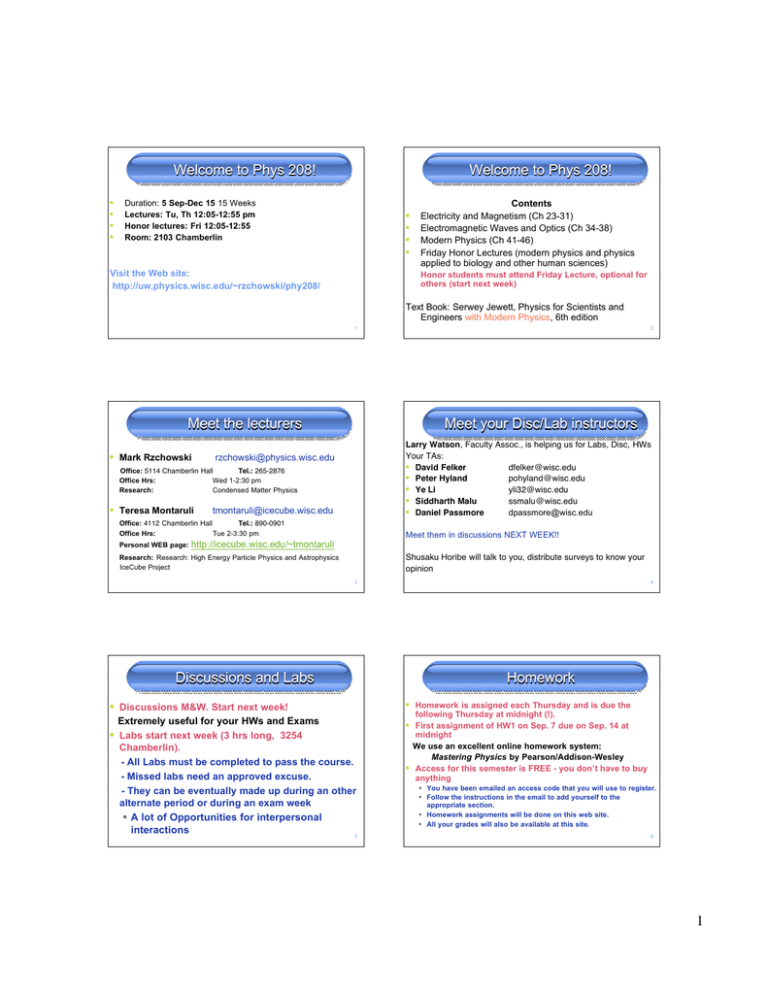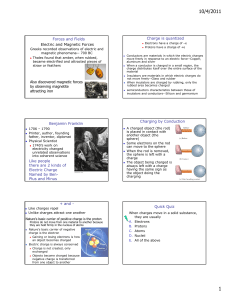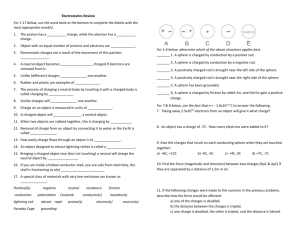
Welcome to Phys 208!
•
•
•
•
Welcome to Phys 208!
Duration: 5 Sep-Dec 15 15 Weeks
Lectures: Tu, Th 12:05-12:55 pm
Honor lectures: Fri 12:05-12:55
Room: 2103 Chamberlin
•
•
•
•
Visit the Web site:
http://uw.physics.wisc.edu/~rzchowski/phy208/
Contents
Electricity and Magnetism (Ch 23-31)
Electromagnetic Waves and Optics (Ch 34-38)
Modern Physics (Ch 41-46)
Friday Honor Lectures (modern physics and physics
applied to biology and other human sciences)
Honor students must attend Friday Lecture, optional for
others (start next week)
Text Book: Serwey Jewett, Physics for Scientists and
Engineers with Modern Physics, 6th edition
1
2
Meet the lecturers
• Mark Rzchowski
Meet your Disc/Lab instructors
Larry Watson, Faculty Assoc., is helping us for Labs, Disc, HWs
Your TAs:
• David Felker
dfelker@wisc.edu
• Peter Hyland
pohyland@wisc.edu • Ye Li yli32@wisc.edu • Siddharth Malu
ssmalu@wisc.edu • Daniel Passmore
dpassmore@wisc.edu
rzchowski@physics.wisc.edu
Office: 5114 Chamberlin Hall
Tel.: 265-2876
Office Hrs:
Wed 1-2:30 pm
Research:
Condensed Matter Physics
• Teresa Montaruli
tmontaruli@icecube.wisc.edu
Office: 4112 Chamberlin Hall
Tel.: 890-0901
Office Hrs:
Tue 2-3:30 pm
Personal WEB page:
Meet them in discussions NEXT WEEK!!
http://icecube.wisc.edu/~tmontaruli
Shusaku Horibe will talk to you, distribute surveys to know your
opinion
Research: Research: High Energy Particle Physics and Astrophysics
IceCube Project
3
4
Discussions and Labs
• Discussions M&W. Start next week!
•
Extremely useful for your HWs and Exams
Labs start next week (3 hrs long, 3254
Chamberlin).
- All Labs must be completed to pass the course.
- Missed labs need an approved excuse.
- They can be eventually made up during an other
alternate period or during an exam week
A lot of Opportunities for interpersonal
interactions
5
Homework
• Homework is assigned each Thursday and is due the
following Thursday at midnight (!).
• First assignment of HW1 on Sep. 7 due on Sep. 14 at
•
midnight
We use an excellent online homework system:
Mastering Physics by Pearson/Addison-Wesley
Access for this semester is FREE - you don’t have to buy
anything
You have been emailed an access code that you will use to register.
Follow the instructions in the email to add yourself to the
appropriate section.
Homework assignments will be done on this web site.
All your grades will also be available at this site.
6
1
Meet your colleagues!
We need to improve
connections between
Physics and other Human
Sciences such as Biology!
• 161 students enrolled,
•
•
Exam schedule
mostly Bachelor of
Science, Natural
Sciences,
Bachelor of Arts
Will continue mainly in
Biological Sciences,
Agriculture, Math,
Physics, Medicine
Some in Engineering
•
•
•
•
Try to have examples to use
physics methods to
understand processes
happening in Humans and
Nature!
Exam 1: Oct 4 1:30 hrs 5:30-7 pm
Exam 2: Nov 1 1:30 hrs 5:30-7 pm
Exam 3: Nov 29 1:30 hrs 5:30-7 pm
Final Exam: Dec 20 7:25-9:25 pm
• Remember: exams are the main determining
factor in the grade (65%)!!!
7
8
Grading
P208 Suggestions
• Not everything you need for exams is in lectures!
Part of the exam work
Weight for your
final grade
Comments
Labs
8% (-30% if 1 lost)
9/10 required to pass the
course
Lab Write up
7%
1 assigned at the end of
Labs
DISC
10%
Mon & Wed
HW
10%
Mastering Physics
Exams:
MTE1
MTE2
MTE3
Final
15 %
15%
15%
20%
1:30 hrs
1:30 hrs
1:30 hrs
2:00 hrs
Lectures present: Concepts, Connections, Motivations
• However, help yourselves with
•
•
9
Textbook (Read it - before & after the lecture)
Attend Discussions + and do your Homeworks
Hands-On: Labs
Taking Notes
Lecture notes available in the WEB site.
Augment with your own notes.
Understanding
Ask questions in lectures, discussions sessions!
Discuss problems with others, but try to solve problems
on your own.
10
+ and - charges can be separated
Electric Charges
• There are two kinds of electric charges
• Triboelectric
Called positive and negative (after B. Franklin 1706-1790)
• Negative charges are electrons
• Positive charges are protons
• Matter is globally neutral: atoms are made of
A positively charged central nucleus
r~10 -15 m
Negatively charged electrons orbit
around the nucleus r~10 -10 m
Charge is transferred as a result of
mechanical (frictional) action
• Conduction
charge transfer by contact (spark)
Example: Lithium
3 protons in nucleus + 3 electrons
(also neutrons in nucleus)
11
12
2
Sign of Charge
Conservation of Electric Charge
Triboelectric
- glass rod rubbed with silk ⇒ positive (electrons
transferred from glass rod to silk)
- rubber rod rubbed with fur ⇒ negative
Charges of the same sign repel one another and
charges with opposite signs attract one another
(electrons transferred from fur to robber rod)
Charge is always conserved!!
It cannot be created or
destroyed.
13
Demo: stir-up + rods
14
Conductors
Quantization of Electric Charges
• Electrical conductors are materials in which some of the
electrons are free and can move through the material
• The SI unit of charge is Coulomb (C )
• The electric charge, q, is said to be quantized
• Good conductors: copper, iron, aluminum and silver
(R. Millikan, 1868-1953)
quantized = it is some integer multiple of a
fundamental amount of charge e
q = Ne
• N is an integer
• e is the charge of an electron = 1.6 x 10 -19 C
• Electron: q = -e
• Proton: q = +e
• Earth: conductor with infinite storage capability
• Usually good electrical conductors are also good thermal
conductors (free electron motion is main mechanism for heat
conduction)
• When a good conductor is charged in a small region, the
15
charge readily distributes itself over the entire surface of the
material
Insulators or Dielectrics
16
Semiconductors
• Electrical insulators: all electrons are tightly bound to atoms
• The electrical properties of semiconductors are
• Good insulators: glass, rubber and wood
• Air is a good insulator except when molecules become ionized
(dielectric breakdown = a spark is produced between
conducting surfaces, eg. lightning may discharge by transfer to
the Earth )
•
•
somewhere between those of insulators and
conductors
Examples of semiconductor materials include
silicon and germanium
Used for chips in computers, cellular phones,…
• Usually good electrical insulators are also good thermal
insulators
• When a good insulator is charged in a small region, the charge
is unable to move to other regions of the material
17
18
3
Solutions
Solutions
• Mixture of a solvent (most abundant component) and solutes
• Solutions with ions (charged atoms or molecules) conduct
•
•
•
•
electricity
Giving up electron leaves a + charge (cation)
Taking on electron produces a - charge (anion)
Biological examples of liquid solutions: blood, intracellular fluid
Pure Water is a good insulator but the normal high conductivity
of water is due to the presence of salts and metal ions
•Na+ and K+ cations (monovalent = 1 charge): carry
electricity in excitable cells, such as nerves and
muscles
•Substance which donates H+ ions to solution = acid
•Substance which donates OH- ions to solution = base
•Physiologists have devised a logarithmic unit:
pH = - log [H+], where [H+] is the H ion
concentration in moles/liter
•high pH: few H+
low pH: many H+
19
Interactions between charges
Charging by conduction (touching)
+- +
- -+ + - +
+ + + + + + + + + + ++
Positively charged rod
(too few electrons)
+ + + + + + + + + + ++
electron flow
+
+
+ +
Less positively charged rod
Why did the electrons flow?
Neutral
metal
attractive force between positive and negative
charges.
+-+
- -+ + - +
+ +
+
+
+
+ + +
repulsive force between two positive or two negative
charge
Positively
charged
metal
21
Charging conductors by Induction
• Charging by induction requires no contact with the
object inducing the charge
a)
b)
charged rubber rod
a) We start with a
neutral metallic sphere
20
b) The rod does not touch the
sphere. The electrons in the
neutral sphere are
23
redistributed
22
Charging by Induction, 2
If the sphere is grounded, some
electrons can leave the sphere
through the ground wire
When the ground wire is removed
there is still a net positive charge
on the sphere ⇒ positive charge
has been induced in the sphere.
When rod removed, electrons will
redistribute in the sphere.
24
4
Electroscope
Quick Quiz
A negatively charged rod is used
to charge an electroscope by
induction. What is the resulting
net charge on the electroscope
leaves?
The positively charged rod attracts
negative charges to the top of
the electroscope.
This leaves positive charges on
the leaves.
1)
2)
3)
The like-charges on the leaves
repel each other.
Positive
charged
rod results
in positive
leaves.
Positive.
Zero.
Negative.
If negative charged rod were used, negative charges from the
top of the electroscope are repelled and drift to the leaves which
end up with a net negative charge, while the top of the
26
electroscope is positive.
25
Electroscope: next Lab
Coulomb’s Law
Charge Rearrangement in Insulators
• A process similar to
• Electrical force between two stationary charged particles
•
• The SI unit of charge is the coulomb (C ), µC = 10-6 C
• 1 C corresponds to 6.24 x 1018 electrons or protons
• ke = Coulomb constant ≈ 9 x 109 N.m2/C2 = 1/(4"εo)
induction can take
place in insulators
The charges within
the molecules of the
material are
rearranged
εo = permittivity of free space = 8.854 x 10 -12 C2 / N.m2
Gravitational force: FG=GM1M2/ r2
G=6.7x10 -11 Nm2/kg 2
27
28
Hydrogen Atom Example
Vector Nature of Electric Force
a)The force is repulsive if charges are of like sign
b)The force is attractive if charges are of opposite sign
The force is a conservative force
Electrical forces obey Newton’s Third Law:
F21 = -F12
• The magnitude of the electric force between the electron and
•
proton:
Fe = ke|e| |-e| / r2 = 8.2 x 10 -8 N, r ~ 0.53 x 10 -10 m
The gravitational force between the electron and the proton
Fg = Gmemp / r2 = 3.6 x 10 -47 N
me = 9.11 x 10 -31 kg, mp = 1.67 x 10 -27 kg
G = 6.67 x 10 -11 N m2/kg 2
Fe/Fg ~ 2 x 10 39 N!!!
Mp=1.67x10-27 kg
Me = 9.11 x10 -31 kg
+
r = 0.53x10 -10 m
29
30
5
Quiz: Induced Dipole
Quick Quiz 1
A positive and negative charge with equal magnitude are connected by
a rigid insulating rod, and placed near a negative charge. What is the
net force on the two connected charges?
1) Left
2) Zero
3) Right
An uncharged conducting sphere is hung between a negatively
charged sphere and a grounded sphere and held midway between
the two. What happens when the uncharged sphere is released?
B
1) Positive charge is attracted (force to left)
2) Negative charge is repelled (force to right)
+
-
F=
kq1q2
r2
31
C
32
Induced Dipole
Induced Dipole
An uncharged conducting sphere is hung between a charged sphere
and a grounded sphere and held midway between the two. What
happens when the uncharged sphere is released?
-
A
+
Electrons on A move far from B towards C
• Negative charge attracts + repels -
3) Positive charge is closer so force to left is larger.
-
-
An uncharged conducting sphere is hung between a charged sphere
and a grounded sphere and held midway between the two. What
happens when the uncharged sphere is released?
A
+ -
1) Negative charge attracts + repels 2) Since + is closer, attractive force is strongest
33
Question?
1) Negative charge attracts + repels –
2) Since + is closer, attractive force is strongest
3) Once they touch both are negatively charged, and then
repel
1) Touches grounded sphere and becomes neutral again
34
Ben Franklin’s door bell
If the conducting sphere is replaced by an uncharged
insulating sphere, what will happen when it is released?
Sticks to charged sphere.
Sticks to grounded sphere.
Nothing.
Swings back and forth between charged and grounded
spheres.
+ +
+ +
- - -
+ +
+ +
-
Charges can not separate in insulator, so net force is
35
zero
36
6



